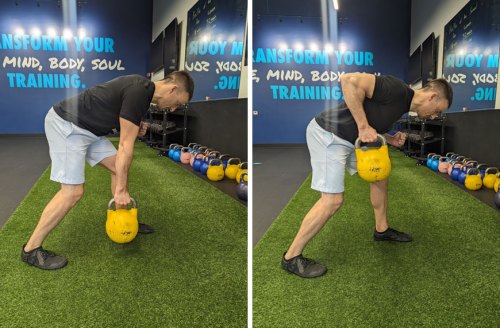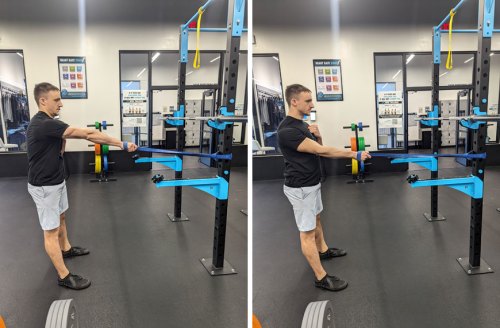Can’t Do a Pull-Up? These 5 Alternative Moves Are Just As Effective
Discover pull-up alternatives you can do at home. The trainer-approved exercises allow you to work the same muscles, no pull-up bar required.

There’s a reason why trainers swear by pull-ups: The move works every muscle in your upper body. But while they’re all-stars at increasing your strength, doing a pull-up (and, most importantly, doing one correctly) is easier said than done.
Experts in This Article
certified personal trainer and creator of BodyFit by Amy
master instructor and head coach with Body Fit Training
co-founder of Trooper Fitness
“Pull-ups are absolutely harder than most people think,” says Eddie Deedon, master instructor and head coach with Body Fit Training. “For someone who has yet to accomplish their first pull-up, they’re training with a weight that’s over their maximal strength level. It would be like trying to increase your max deadlift from 100 to 200 pounds by training with 200 pounds.”
That’s where pull-up alternatives can come in handy—aka the exercises you can use to achieve the upper-body strength required to complete your first full pull-up, Deedon says. Or, if you’ve already conquered that challenge, they can help you refine your technique.
Below, learn all the ins and outs of the classic move—from the benefits of doing pull-ups in the first place to beginner-friendly substitutes for pull-ups that will turn you into a pro.
What is a pull-up?
The pull-up is a classic bodyweight exercise. “It’s performed by hanging from a horizontal bar with straight arms, and pulling your body up until your chest or collar bones make contact with the bar,” Deedon says. When comparing the pull-up vs. chin-up, the pull-up uses an overhand grip while the chin-up uses an underhand grip.
If you want to build your upper-body strength, the pull-up is one of the best arm and back workout options for the job. “The primary muscles contributing to the movement are the large muscles on the back called latissimus dorsi—or ‘lats’ for short—and the biceps on the front of the arm,” he says.
With that being said, you’re also working your forearms, rear delts, and mid and lower traps. And, so long as the rest of your body is tense—think your core, glutes, and legs—he says it becomes more of a full-body exercise.
3 benefits of adding pull-ups into your routine
Pull-ups—even modified versions like the jumping pull-up—are one of the most beneficial moves to include in a general strength training program. Here’s exactly why you might want to add this bodyweight exercise into your own routine.
1. They improve your upper-body strength
At this point, you know pull-ups are a great way to improve your upper-body strength. With each upward motion, as you bring your chest or collar bones toward the bar, you’re building muscle in your biceps, lats, forearms, traps, and more.
This heightened upper-body strength isn’t just important now (think of all the boxes and heavy objects you’ll be able to carry without a problem!), but it also plays a crucial role in maintaining independence as you age.
2. They make other exercises easier
Once you’ve nailed the pull-up, a new door of possibilities opens.
“Not only is it cool to have the confidence knowing you have enough mastery over your own bodyweight to pull yourself up to a bar, but the lats start at your hips and connect at the top of your arms. Therefore, they’re literally the muscle that connects your upper body to your lower body,” Deedon says. “Having strong lats greatly improves your ability to transduce force through your body, no matter what exercise or physical activity you’re performing.”
3. They improve your grip strength
The grip strength developed through pull-ups isn’t just helpful in your workouts, but also in everyday movements like carrying bags of groceries or using a screwdriver.
Conversely, a lack of grip strength may lead to muscle imbalances and increase your risk of injury.
“If done correctly, pull-ups can help build strength in those muscle groups, which can lead to improvements on things like grip strength, shoulder stability, and help to develop kinesthetic awareness,” Rafique Cabral, personal trainer and Isopure Athlete, previously told Well+Good.
Who should do pull-up alternatives?
You may be tempted to jump right into full-on pull-ups, but holding off and instead focusing on alternative exercises is essential for establishing both foundational strength and technique. Here are some instances where sticking to substitutes for pull-ups is key.
1. You’re not quite ready for full pull-ups
If you can’t yet perform step-by-step pull-ups, no worries. Deedon says strength training without pull-ups is a good idea until you’re fully ready for the real deal.
“If you’re wanting to work up to a full pull-up, the reason we would want you to focus on training regressed variations is because we generally don’t want you training at or near maximal intensity,” Deedon says. “When training for strength, it’s almost always a better plan to train with submaximal loads so that we can practice the movement and build up a lot of high-quality volume, as opposed to burning yourself out by constantly frying the muscles to failure.”
2. You want to perfect your form
Deedon says pull-up alternatives aren’t just a great way to work up to a full pull-up. These arm and back workout options are also beneficial for anyone who can already perform a pull-up and is simply hoping to perfect their form.
“Even with people that can perform pull-ups for repetitions, a lot of the smaller details are usually ignored. This could include a lack of shoulder retraction to initiate the movement, no bracing through the midsection—resulting in ‘flopping’ on the bar like a fish—and, most common of all, partial range of motion. Full range of motion on a pull-up for someone with healthy joints starts at the bottom with completely locked elbows, to the top position with the chest in contact with the bar. It’s very common to see people stopping short of both of these points.”
Even if there’s just one aspect of a pull-up that you find difficult, taking a step back and focusing on alternative exercises can be helpful.
“There may be a specific part of the exercise that an individual is finding most challenging—such as retracting the shoulders or touching their chest to the bar—and the correct variation of a pull-up can help smooth out these sticking points,” Deedon says.
3. You have an injury
If you have an injury that’s limiting your ability to perform a full pull-up, doing pull-up alternatives can allow you to continue to build up your strength as you heal.
With that being said, Deedon says to always consult your doctor or physical therapist about the best routine for your specific situation. Otherwise, you risk further injury.
4. You don’t have access to a pull-up bar
Not everyone has access to a pull-up bar. But that doesn’t mean you can’t work the same muscles you would in a traditional pull-up. There are home workout alternatives that offer strength training without pull-ups, allowing you to improve your upper body strength with no or minimal equipment.
5 best pull-up alternatives to build your strength
No pull-up equipment? No problem. Deedon’s diverse back and arm exercises below have you covered.
You’ll find pull-up alternatives with bodyweight, pull-up alternatives with dumbbells or kettlebells, and pull-up alternatives with no bar.
You can use them as part of a progression plan, allowing you to gradually build up the strength required to perform pull-ups with perfect form.
1. Row
How do you mimic pull-ups with dumbbells or kettlebells, you ask? You choose exercises that work similar muscles.
Rows allow you to build your upper body strength, no pull-up equipment needed. This pull-up alternative with dumbbells or kettlebells primarily works your lats, middle and lower traps, rhomboids, and posterior delts.
“This is a great exercise to improve posture and combat the muscle imbalances or tightness you might feel from sitting at a desk all day,” Amy Schemper, CPT, BowFlex fitness advisor, previously told Well+Good.

- 1.Stand with your feet hip-width apart, holding a kettlebell or dumbbell in your right hand, arms at your sides.
- 2.Step your left foot forward 1-2 feet to stabilize your body.
- 3.Bend your knees, push your hips back, and bend your torso forward. Ensure that your shoulders are back and your spine is straight.
- 4.Extend your right arm up and back toward your hips until your elbow is at a 90-degree angle.
- 5.Slowly lower your arm back down.
- 6.Complete three sets of 12 reps on each arm.
2. Push-up
Next up, a pull-up alternative using your body weight: the push-up. When you integrate this move into your fitness routine, you can develop the strength required not only for pull-ups but also for a myriad of other exercises.
“In order to maximally engage the lats, focus on ‘corkscrewing’ your hands into the ground and pulling your shoulders down away from your ears,” Deedon says. “Stay tight through the midsection and think of the exercise as a moving plank.”

- 1.Start in a tabletop position on your hands and knees, hands under your shoulders and knees under your hips.
- 2.Step your feet back and straighten your legs so you’re in a high plank position. Your body should make a straight line from head to toes, and your hands should be directly under your shoulders. Keep your fingers pointed forward.
- 3.Bend your elbows and lower your body to the floor.
- 4.Press into your palms to push back up into high plank position.
- 5.Perform three sets of 12 reps.
3. Table row
Don’t have access to a gym? While Deedon is shown performing the table row on a bar, if you’re looking for a pull-up alternative with no equipment, he says home workout alternatives can include a sturdy table or countertop. (Who would have thought your home decor could become equipment substitutes for pull-up alternatives?)

- 1.Situate yourself so your body is under a sturdy table or bar.
- 2.Grip the bar or table tightly (with an overhand grip) and walk your feet out so your body forms a long, straight line. Dig your heels into the ground and point your toes up to the ceiling.
- 3.Bend your elbows to lift your chest toward the table or bar. “Focus on keeping your shoulders down and move your whole body as one solid unit,” Deedon says.
- 4.Lower back down to starting position.
- 5.Perform three sets of 12 reps.
4. Banded shoulder retraction
If you’re looking for another diverse back exercise, grab a resistance band. The pull-up alternative with no bar allows you to build your upper-body muscles.

- 1.Mount a resistance band to something sturdy at about chest height.
- 2.Holding onto the band with your right arm straight out in front of you, move forward a few inches (or enough to create tension on the band).
- 3.Pull your shoulder back and down away from the anchor point of the band.
- 4.Slowly release your arm to your starting position.
- 5.Complete three sets of 12 reps on each arm.
5. Banded pull-apart
The last pull-up alternative with no bar is the banded pull-apart. It’s a great home workout option, as no pull-up equipment is needed to increase your upper-body strength. Just grab your trusty resistance band and get to work.

- 1.Stand tall with your feet hip-width apart.
- 2.Hold a resistance band with an overhand grip with one hand near each end at chest height. Your arms should be straight.
- 3.Pull the band apart while pulling your shoulder blades together. Pull as wide as your mobility allows while maintaining your posture.
- 4.Return to your starting position.
- 5.Complete three sets of 12 reps.
FAQ
1. How do beginners learn pull-ups at home?
Pull-ups are one of the best arm and back workout options for building upper body strength. With that being said, they take a lot of muscle power to master.
Beginners can use alternative exercises that build up the muscles needed to perform pull-ups correctly. Strength training without pull-ups can include exercises like rows, push-ups, and banded pull-aparts, according to Deedon.
2. How can I do pull-ups at home without equipment?
Pull-ups are one of the best arm and back workout options for building upper-body strength. If you’re at home and don’t have a pull-up bar to work with, there are pull-up alternatives with no equipment that you can do from anywhere.
One of the best ways to get in your strength-training without pull-ups is through table rows, according to Deedon. Instead of lifting your chest toward a pull-up bar, you’re building upper-body strength by lifting toward a sturdy table. If you want other at-home workout options, try compound bodyweight exercises.
Sign Up for Our Daily Newsletter
Get all the latest in wellness, trends, food, fitness, beauty, and more delivered right to your inbox.
Got it, you've been added to our email list.










